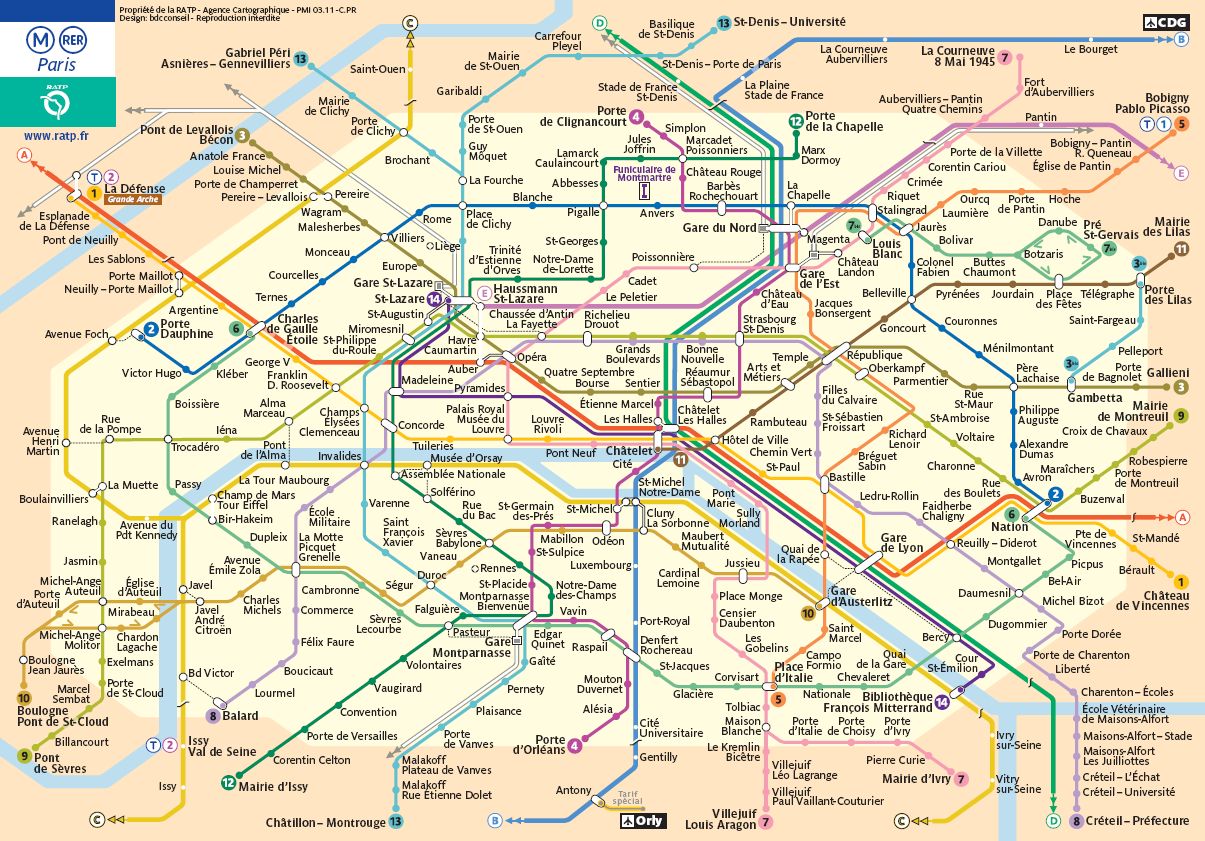Travelling Around Paris
Thursday 30 September 2010
Travelling around Paris is cheap and easy if you are prepared to use the extensive Métro system in the city.
Paris is blessed with the largest underground rail system in Europe. The public transport operator RATP (Régie Autonome des Transports Parisiens) claims that no building in the city is located further than 500 metres from an underground station.
That is an impression easily gained when you travel on the system, for there are very frequent stops on the train. The trains also run very regularly.
It is also surprising just how fast it is to travel across the city. Most destinations can be reached within a matter of minutes, and you can generally cross from one side of the city to the next in less than half an hour.
One of the great advantages of the system is that it is linked to the overground commuter line ‘RER’ (Réseau Express Régional) system, so that within the city boundary it is possible to use a single ticket purchased on the Métro to transfer to the commuter express rail service.
If you need to go further afield into the wider Ile de France, then you will need to buy another commuter line ticket.
Separate tickets also need to be purchased if you wish to use the bus and tram systems in the city, as connections between bus and tube on the same ticket are not permitted.
Buying Tickets
A ticket for the Métro system costs €1.70, which will take you anywhere within the city walls (there are no fare zones), using either (or both) the underground and commuter rail network.
If you plan to use the system more than a few times, then buy a carnet of 10 tickets for €12. Tickets are half price for children aged 4 to 9, and those under 3 travel free of charge.
There are other special money saving deals you can get, but given the cheap price of a carnet of tickets, they are probably not worth the bother that is sometimes involved (passports needed in some cases).
If you are staying for a long period, then the NaviGo pass is the ticket option of choice for most Parisiens, and NaviGo Découverte is a good choice for visitors staying for 5 days or more and likely to travel regularly on the system.
You can buy your daily and weekly tickets at automatic machines at the stations, or from one of the few ticket offices available. The instructions on the machines are available in the English language, and accept either cash or credit cards.
The ticket is inserted into the turnstiles at the entrance to the station, with the magnetic side downwards. It will appear on the other side of the turnstile, so keep it for travelling further or checking by an inspector.
Riding the Trains
There are 16 lines covering the underground system, with each one identified by number and colour code.
Each line on the system is known by the number of the line (1 to 16) and the terminus points. So Line 4 is known as Porte de Clignancourt/Porte d'Orléans because these are the terminus points at either end of the line.
Accordingly, when you enter a station you need to check the direction of travel of the line, to go to the destination you seek on that line. In this case, if you were heading north you would follow the route for Porte de Clignancourt, and if south, the route for Porte d'Orléans.
If you wish to change from one line to another it is easy to do so at connecting stations.
There are five RER lines that cross the city, each one identified on the underground map by the letter A, B, C, D, or E.
Signage is plentiful and clear on the system, so take your time to use it when you enter the stations.
The RATP offer a useful route planning guide in English, which is worth consulting prior to your visit, in order to help you understand how to use the system.
There is very little waiting time at the stations, so you need to be ready when the train pulls in to jump on the train.
Except on some of the newer trains, doors do not open automatically, although with other passengers embarking and disembarking you are unlikely to have to do this yourself.
Trains start at 05.30 until 12.40am Sunday to Thursday and until 01.40am on Fridays. They run every two to three minutes during rush hours, and around every six minutes at other times.
Airport Links
If you wish to travel to Orly airport by train then you need to travel on the special ‘Orlyval’ automatic train service, which runs out of Antony station on the RER B line.
If you wish to travel to Charles de Gaulle station, then take the fast train from the Gare du Nord.
There are also separate and shuttle bus services to and from the airports.
Thank you for showing an interest in our News section.
Our News section is no longer being published although our catalogue of articles remains in place.
If you found our News useful, please have a look at France Insider, our subscription based News service with in-depth analysis, or our authoritative Guides to France.
If you require advice and assistance with the purchase of French property and moving to France, then take a look at the France Insider Property Clinic.






